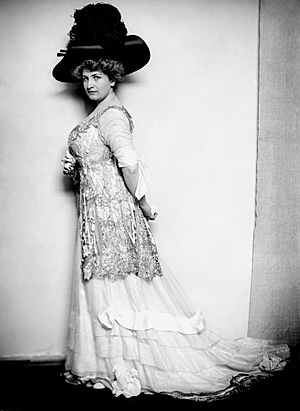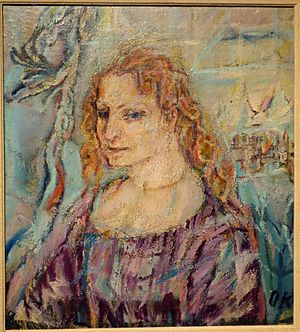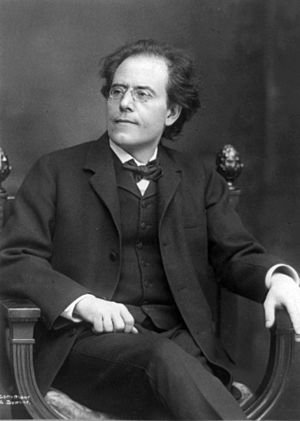Alma Mahler facts for kids
Quick facts for kids
Alma Mahler
|
|
|---|---|

Alma Mahler in 1909
|
|
| Born |
Alma Margaretha Maria Schindler
31 August 1879 |
| Died | 11 December 1964 (aged 85) New York City, New York, U.S.
|
| Burial place | Grinzing Cemetery, Vienna |
| Nationality | Austrian, American |
| Occupation | Composer, socialite, author, editor |
| Spouse(s) |
|
| Children |
|
Alma Maria Mahler Gropius Werfel (born Alma Margaretha Maria Schindler; August 31, 1879 – December 11, 1964) was an Austrian composer, writer, and editor. She was also known for being part of important social groups.
From a young age, Alma was very musical. She wrote almost fifty songs for voice and piano. She also created works in other musical styles. Today, only 17 of her songs are still known to exist.
Contents
Alma's Early Life
Alma Maria Schindler was born on August 31, 1879, in Vienna, Austria. At that time, Vienna was part of Austria-Hungary. Her father, Emil Jakob Schindler, was a famous landscape painter. Her mother was Anna Sofie.
Alma was taught at home and grew up in the Catholic Church. In 1886, the Crown Prince Rudolf liked her father's paintings. He asked Emil Schindler to travel with his family to the Adriatic coast. There, he would paint landscapes. In 1892, the family also visited the island of Sylt. Alma's father, Emil Schindler, died there.
After her father passed away, Alma focused on playing the piano. She studied how to compose music and write melodies with Josef Labor. He was a blind organ player who taught her many things. When she was 15, Alma went to school for only a few months.
As she got older, Alma had measles as a child. This caused her to have some hearing loss. Max Burckhard, a friend of her father and director of Vienna's Burgtheater theater, became her guide. On Alma's 17th birthday, Burckhard gave her many books. In 1895, Alma's mother, Anna Schindler, married Carl Moll. He had been a student of Alma's father. In 1899, Anna and Carl had a daughter named Maria.
Alma met the artist Gustav Klimt through Carl Moll. Moll and Klimt helped start the Vienna Secession. This was a group of artists who wanted to create new art. Klimt was very interested in Alma. While she was interested at first, her feelings changed. Klimt and Alma remained friends until he died. In the fall of 1900, Alma began studying music composition with Alexander von Zemlinsky.
Alma's Marriages and Life Changes
Alma had several important relationships in her life. She studied music with composer and conductor Alexander von Zemlinsky.
Later, she married Gustav Mahler, a very famous composer. Gustav Mahler was not very interested in Alma's own music. This made her feel sad because she loved to compose.
After Gustav Mahler died, Alma married Walter Gropius in 1915. They had a daughter together named Manon Gropius. Her last marriage was to the writer Franz Werfel.
In 1938, a political event called the Anschluss happened. It meant that Austria was taken over by Nazi Germany. It became unsafe for Jewish people. Because of this, Werfel and Alma had to leave Austria. They eventually settled in Los Angeles, USA. In her later years, Alma's home became a popular meeting place for artists. This happened first in Vienna, then in Los Angeles, and finally in New York.
A Cultural Figure in the U.S.
In 1946, Alma Mahler-Werfel became a citizen of the United States. A few years later, she moved to New York City. There, she continued to be an important person in the arts and culture world.
Leonard Bernstein, a famous conductor, admired Gustav Mahler's music. He said that Alma Mahler-Werfel came to some of his music rehearsals. Benjamin Britten, another composer, thought Alma was a special link to both Mahler and Alban Berg. He dedicated his piece Nocturne for Tenor and Small Orchestra to her.
Alma's Death

Alma Mahler-Werfel died on December 11, 1964, in New York City. She was buried on February 8, 1965, in the Grinzing Cemetery in Vienna. She rests in the same grave as her daughter Manon Gropius. Her grave is also close to Gustav Mahler's.
Alma as a Composer
Alma played the piano from when she was a child. In her memories, she wrote that she first tried composing music in 1888. This was on the Greek island of Corfu. She studied composing with Josef Labor from 1894 or 1895 until 1901.
She met Alexander von Zemlinsky in early 1900. She began taking composition lessons from him that fall. She continued to be his student until she got engaged to Gustav Mahler in December 1901. After that, she stopped composing for a while.
Before stopping, she had written or planned many songs. She also created about 20 piano pieces and some chamber music. She even worked on a part of an opera. She briefly started composing again in 1910, but stopped in 1915.
It is hard to know the exact order of her compositions. This is because she did not put dates on her music papers. She also destroyed many of them herself. Experts like Susanne Rode-Breymann and Knud Martner have tried to create lists of her works.
A total of 17 of her songs still exist today. Fourteen of these were published while she was alive. They came out in three books in 1910, 1915, and 1924. The first two books were published under the name Alma Maria Schindler-Mahler. The last book was called "Fünf Gesänge" by Alma Maria Mahler. The cover of the 1915 set had a drawing by Oskar Kokoschka.
Three more songs were found after she died. Two of them were published in 2000. One more was published in 2018. Her personal papers, including her music, are kept in different places. These include the University of Pennsylvania, the Austrian National Library in Vienna, and the Bavarian State Library in Munich. Her songs have been performed and recorded often since the 1980s. Many of her songs have also been arranged for orchestras.
Alma's Musical Works
Here are some of the songs Alma Mahler composed:
- Five Songs for voice and piano (published in January 1911)
- Die stille Stadt (The Quiet Town)
- In meines Vaters Garten (In My Father's Garden)
- Laue Sommernacht (Mild Summer's Night)
- Bei dir ist es traut (With You It Is Pleasant)
- Ich wandle unter Blumen (I Stroll Among Flowers)
- Four Songs for voice and piano (published in June 1915)
- Licht in der Nacht (Light in the Night)
- Waldseligkeit (Woodland Bliss)
- Ansturm (Storm)
- Erntelied (Harvest Song)
- Five Songs for voice and piano (published in April 1924)
- Hymne (Hymn)
- Ekstase (Ecstasy)
- Der Erkennende (The Recognizer)
- Lobgesang (Song of Praise)
- Hymne an die Nacht (Hymn to the Night)
Songs published after her death
- Leise weht ein erstes Blühn (Softly Drifts a First Blossom), for voice and piano (published 2000)
- Kennst du meine Nächte? (Do You Know My Nights?), for voice and piano (published 2000)
- Einsamer Gang (Lonely Walk), for voice and piano (published 2018)
Images for kids
-
House of Franz Werfel and Alma Mahler in Sanary-sur-Mer
See also
 In Spanish: Alma Mahler para niños
In Spanish: Alma Mahler para niños



